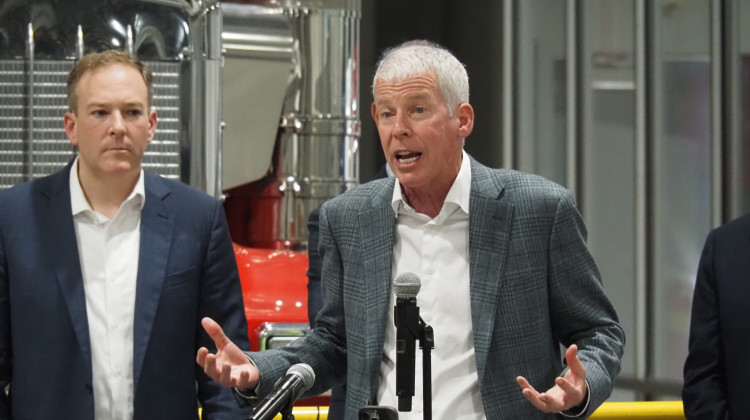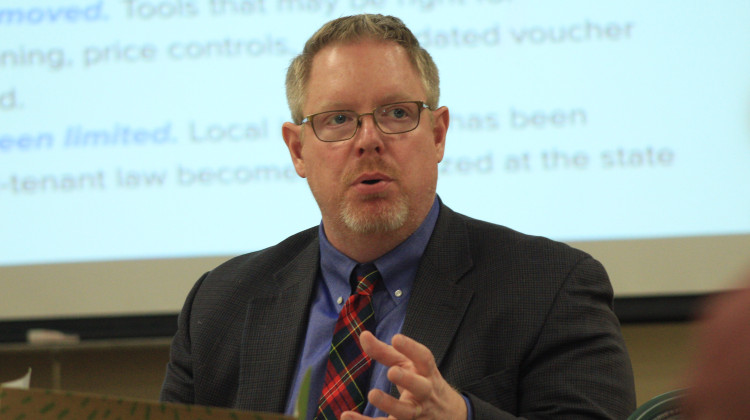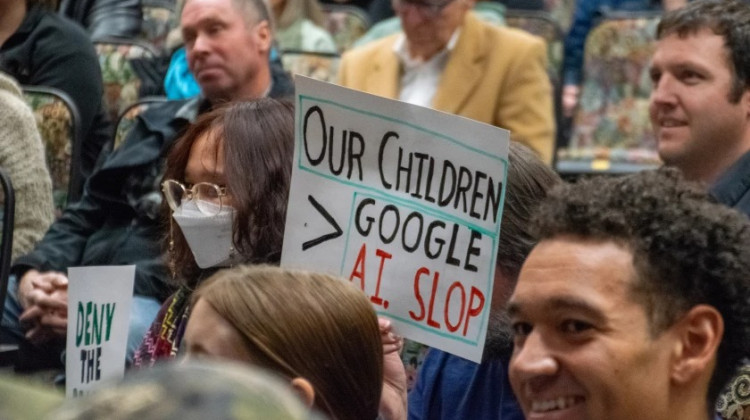
Indianapolis recorded 271 homicides in 2021, breaking the record for the second consecutive year.
Tony Webster/CC BY-NC-ND 2.0For Rev. Malachi Walker, Indianapolis’ homicide rate is personal.
Walker’s 24-year-old daughter was killed by two home invaders, who shot her about 10 years ago.
A decade later, her murder is still unsolved, no one was convicted of the crime. Walker says his family thinks they know who killed her, but there was not enough evidence to file charges.
“That’s just part of the system, the broken system I call it, that we kind of have to live with,” he said.
Walker is a pastor at Great Commission Church of God in the city’s northeast side and leads Young Men Inc., a faith-based organization that works to empower young men and help them grow as individuals.
“I can say that it made me stronger, and now we'll continue this fight out here,” Walker said.
He is one of Indianapolis’ many community leaders concerned about the increasing homicide rate and working to address it.
The numbers
It was a deadly year. Indianapolis recorded 271 homicides in 2021, breaking the record for the second consecutive year. Of those, 249 were classified as criminal homicides, or killings where intent was suspected. And as of Jan. 10, arrests haven't been made in 60% of the cases.
In 2020, IMPD recorded 245 homicides, 214 of which were considered criminal.
There were 31 murder trials prosecuted in Marion County last year, but only one involved a 2021 homicide. It can take months or years for a case to work its way through the criminal justice process. Prosecutors also have a higher burden of proof than police in order to charge someone with a crime. And that waiting exacts another toll.
IUPUI criminal justice professor Thomas Stucky says it’s essential to remember that every number represents a life lost.
“It’s really important that we think about each of these instances individually as a person whose life is lost, and that the individual's family and friends and the community are forever impacted by that,” he said.
Why were there so many homicides this year?
Law enforcement, community leaders and academics working to decrease the number of homicides all grapple with pinpointing causes of the recent increases. Most say the pandemic, poverty, societal friction and guns have all played a role.
Experts and law enforcement agree that the pandemic exacerbated some crime issues, like homicide, drug use and domestic disputes. Many Hoosiers were also left unemployed and grew desperate to make ends meet.
“I think there's a lot of frustrations that are boiling over with people being more restricted than they have been in years past. And so maybe they're more quick to anger and quick to act on frustrations than they might have been a couple of years ago,” said Capt. Roger Spurgeon, commander of IMPD’s homicide branch.
That circumstance added tension to already existing social stress.
Ernesto Lopez, a research specialist with the Council on Criminal Justice, a national organization that studies crime, said there was a spike in crime nationally following George Floyd’s murder and social unrest, which may have seeped into 2021.
“It's difficult to say what it was about George Floyd’s murder that caused or is associated with this increase in homicide, whether it's policing, with police withdrawing, or public trust, we can't really separate those mechanisms,” Lopez said.
READ MORE: Pandemic, Economic Uncertainty Have Led to Increased Gun Violence, Expert Says
And all of that was laid over already existing cycles of violence that plague poverty-stricken communities. Pastor David Greene, president of the Indianapolis Concerned Clergy, said poverty is always a key root cause of violent crime.
“It comes back to economics and dollars, and when you don't have economics and dollars, you see all this other stuff manifest itself in ugly ways,” Greene said. “People are trying to make it, so they're going to do anything to make it and they're going to take chances, and they're going to take risks, and that's going to lead to the violence.”
Finally, many point to the availability of firearms in Indiana. And gun purchases surged nationally during the pandemic. According to Northwestern University, the FBI saw a new high of 21 million background checks in 2020, an increase of 26% compared to the previous record set in 2016.
Marion County Prosecutor Ryan Mears said firearms significantly increase the chance of disputes escalating to killings.
“I think the fact that everybody is armed, or there's a lot of people out there who are armed, heightens the tension in every single confrontation,” Mears said. “And so because of that, I think people feel like they need to act, or they need to be the first person to use their gun, because I think the person that they're having the argument with is also armed.”
There were 236 homicides committed with a gun last year.
Why are so many homicides unsolved? Lack of public trust.
Many working to decrease violence say mistrust between community law enforcement contributes to many unsolved cases.
Indianapolis has a clearance rate just over 54% for 2021, according to IMPD. A case is considered “cleared” once an arrest has been made. No charges or convictions are needed for a case to be considered cleared. That percentage includes crimes that happened in other years but were not solved until 2021.
Oftentimes residents who have information about crimes or witness them are hesitant to come forward, because they don’t trust police and they fear retaliation.
That fuels a vicious cycle – as more and more cases are unsolved, and no arrests or charges take place, people lose even more faith in law enforcement.
Greene says improving the clearance rate is key to bridging the gap between the public and law enforcement.
“If we don't solve the solvability rate, or if we don't improve that rather, then I'm not sure we will see a significant decrease in the homicides,” Greene said.
Spurgeon said he thinks the pandemic may have also led to the relationship between the public and police more distant.
“The fact that since we've gone essentially two years, at different levels of not being able to meet people in person and not have some of the relationship building that we would otherwise have had, there may be an impact there,” he said.
READ MORE: What You Need To Know About IMPD's General Orders Board
READ MORE: What You Should Know About IMPD's Use of Force Review Board
Mears said the national workforce shortage brought on by the pandemic also played a role in the solvability rate. With more homicides occurring, and less law enforcement staff dedicated to solve and prosecute, cases are piling up.
“The unfortunate reality is that more prosecutors are carrying a heavier caseload than what they would ordinarily carry,” Mears said. “It's been a significant burden on our staff, they've done a tremendous job of making sure that we do everything we can, but there's only so much that we can ask of the people who work in the prosecutor's office.”
Spurgeon said sometimes the police think they know who killed someone, but they don’t have enough evidence to make an arrest, like with Walker’s daughter’s case.
“There are a fair number of unsolved cases where our detectives and even the family members and loved ones of the deceased victims, quote, know who did it,” Spurgeon said. “But there's not enough to be able to push it over the top for probable cause to be able to make an arrest.”
Moving forward
As a new year begins, community members and law enforcement say more work needs to be done to prevent another record-breaking year.
Many see improving the relationship between community and law enforcement as a crucial step.
Greene said the community needs to feel more comfortable coming forward with information, and law enforcement needs to show that those individuals will be protected.
“That's a bending on both sides,” he said. “We have some systemic changes that have to be made and we're going to have to work together.”
Mears said his office has been rolling out efforts like reinstating drivers licenses and expunging records to show the community that his office is here to help, not just to put people behind bars.
“We need to continue the work that we're doing to try to help people out,” he said.
Some community members say they want to see more gun control and changes in legislation.
“I say continue to push legislators, push those lawmakers, you know, we continue to put it in their face and tell them, here are the causes, this needs to be changed,” Walker said. “Until then, we’re going to continue to see this spike in homicides.”
Greene says more work needs to be done to reach out to and educate youth.
“We have to be intentional about it, and we have to start with young people, so that as they begin to get older, they get something to live for and don't feel like ‘Well, I don't have anything to live for. So, I'll take a gun and rob a store, rob, whoever and if I shoot them and they shoot me. So be it,” he said. “That’s the mentality. It has to shift and it doesn't shift until you've improved your education.”
Spurgeon says the clearance rate is moving in the right direction. The 2021 rate is 6% higher than it was in 2020.
“To me, that just speaks to just how diligently our detectives are working to try to bring justice to victims, families and the community. You know, they're continuing to work on these cases, do everything that they can to see the justices serve,” he said.
Impact on community
Faith leaders agree that the past year has been particularly draining on them, as they try to help more people in distress and grief.
“So many residents in the neighborhood around my church, and a lot of us clergy in the community are having to try to console all of these people who have been impacted by this violence,” said Rev. Charles Harrison, board member of the city’s Ten Point Coalition.
“And it's draining. It saddens you and also at the same time frustrates you because you see all of this pain out there in the community.”
Greene said he’s had to take on the role of a grief counselor for his congregation in addition to being a pastor.
“It's been extremely stressful, just the number of funerals that we’ve done, being a part of the whole planning process, walking someone through grief,” he said.
Despite everything that has happened since his daughter’s murder, Walker said he’s going to keep advocating against violence and mentoring the community’s youth.
“I'm not going to give up," he said.” But we just got to keep on chopping. It is kind of like a lumberjack. A Lumberjack chops down the tree, he keeps chopping until the tree falls. That's what we have to do to this homicide rate. We’ve got to keep chopping at it. And I strongly believe that one day, we're going to start seeing it turn around to downward instead of going up.”
Contact WFYI criminal justice reporter Katrina Pross at kpross@wfyi.org. Follow on Twitter: @katrina_pross.
Pross is a Corps Member of Report for America, an initiative of The GroundTruth Project.
 DONATE
DONATE






 Support WFYI. We can't do it without you.
Support WFYI. We can't do it without you.